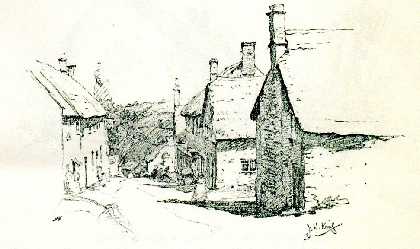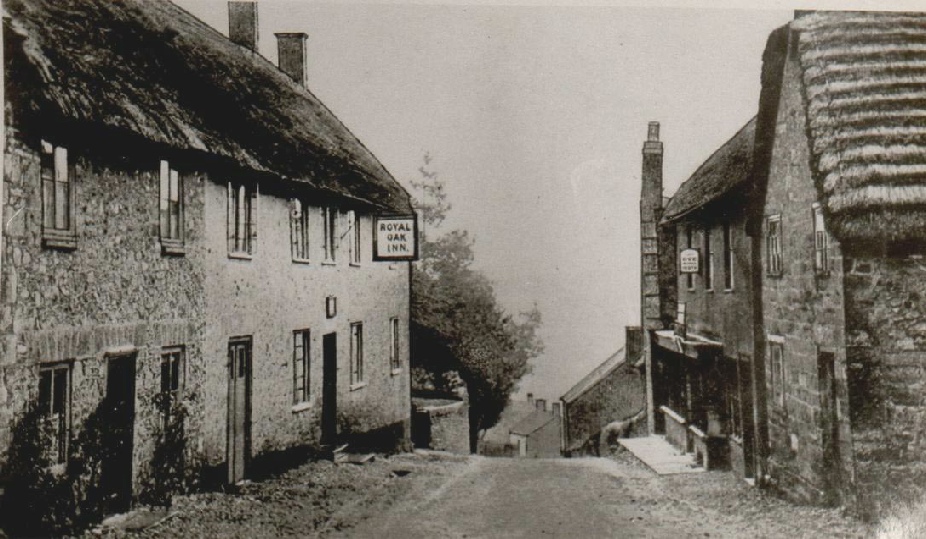THE ROYAL OAK, FORE STREET
The first thing that struck us about The Royal Oak, when we moved here in 1987, was
the welcoming atmosphere, which we soon learned extended through the whole village.
Perhaps old hospitality echoes on. We are certainly grateful to our neighbours for
their information gladly given, especially Mrs Farley senior, Mr Farley, Mr Down
and Mr Masters. The earliest reference we have found to the Royal Oak Inn is a deed
of 1794, but its walls are older. The end wall by the War Memorial, to the top of
the windows is from about 1600, according to the Royal Commission for Historical
Monuments. Lovers carved hearts and initials on the wall long ago. (Broomstick Weddings)
Inside the house, the hamstone work above the windows is reddened, so there was probably
fire and collapse. The other walls are from later in the 17th century. There is little
original work inside, although in the 18th century somebody cut an arch into the
front of a Tudor fireplace, perhaps to warm himself above the knees. At some time
before 1790 the Inn consisted of two properties. This may explain why a branch of
the village sewer runs under the cross-passage.
Landlords
The name ‘The Royal Oak’, or on some OS maps ‘Oak Royal’, is not likely to be earlier
than the Restoration of 1660. But we don’t know when the present name was given,
nor whether there was on earlier inn on the site under another name. The Dorset History
Centre has names of landlords of the Inn from 1851. Some dates may be mid-career.
1851, George Jeffery; 1875, George Gibbs; 1885, Charles Stoodley; 1890, Joseph Hallett;
1895, John Hook; 1903, Henry Hammand; 1911, Walter Paull; 1920, Fowkes Steirn; 1923,
Frederick Jeffery; (Mrs Farley senior’s father); 1927, William Slade; 1931, Arthur
Paull; 1935, John Stevens; 1939, Geoffrey Jones, followed after his death by Mrs
Jones; and Leo Jarvis in the 1950s. So far we haven’t met any ghosts, but if we do
we hope they will offer us a drink – or charge only pre-war prices. What should they
have thought of alcohol-free lager?
We cannot be sure if owners mentioned in earlier deeds were also the Inn landlords.
Fowler, Bagg and Judge all signed a complex deal including both the Inn and some
land and cottages at Hewood. Three wives also signed, and had to appear under a recent
Act before perpetual Commissioners for Somerset, who certified that Mesdammes Berry,
Phillips and Fowlers were ‘of full age and competent understanding, and that they
were each of them freely and voluntarily consented of the same’. Incidentally, Hewood
appears then and in 1772 as Heywood, in 1603 as Hewerwood and in 1658 as Hewood.
In 1794 when George Berry sold the Inn to Joseph Shepherd, Berry had made part of
his living as a fuller. He would have cleansed and thickened cloth by beating and
washing, using fuller’s earth – a silicate of aluminium, now used for cat litter.
By 1829, a George Berry (maybe the one from 1794 or his son) was a clothier, making
or selling woollen cloth, and owning the property. He then sold to William Bagg,
a carpenter. Maybe inn keepers often had a second jobs even in Thorncombe during
the 18th and 19th centuries when the population exceeded 1,000. Mrs Farley senior’s
father, Frederick Jeffery, was also a carpenter. He made water wheels for West Forde
Mill. Arthur Paull broke stones for highways.

Looking down Fore Street, circa 1910, Royal Oak pictured on left 1
Those named in deeds for the Royal Oak dating back to the 17th century were not
necessarily inn keepers. So the buildings and their uses may have changed. There
were the Pinsons: William, 1603; George 1653 and Elizabeth 1658; Bernard Pinney and
Edward Bragge, 1623;John Ganden and Richard Loveridge, 1649, when Sir Henry Rosewell
was at Forde; Joseph Follet in 1769 and John Jeffery in 1772. We would be glad to
learn that William Wordsworth called in for a drink on his walks from Racedown in
the mid 1790's, but so far we have not found a poem to pay for ale. The 1861 census
shows Ann Clark, a gardener and Thomas Ousley parish clerk and letter carrier, as
heads of separate households living in the Royal Oak Yard. Did they live in part
of the hay loft in the barn or the stables? Or were there small cottages in the yard?
Many people living in Thorncombe remember the Royal Oak as a pub. The Golden Lion
was often called the 'Top Pub', the Royal Oak 'Middle Way' (to perdition? or just
half way house?) and the Crown 'Bottom Pub'. From the war memorial end in the early
1920's under Mr Jeffery, the rooms were, a private sitting room, kitchen, cross-passage,
bar and cellar at ground level, with another door to Fore Street for the barrels
from local brewers. Mr Down recalls two bars, one each side of the cross-passage,
both from the earlier time of Walter Paul and from times after Mr Jeffery's. Behind
the inn was a skittle alley where the brewhouse had been. Footballers changed there
too. When landlords did their own butchery, carcases would hang in the alley doorway
for a while. Hot takeaway food was sold from the inn in living memory: tripe and
onions on some days, faggots on some others. The extension now behind the house
is half of what at one time was the Ladies' Snug.
The churchyard wall still carries the brackets which once held a rope to help
patrons uphill and homewards. A merry customer drove an Austin 7 down the path to
the back door. But he couldn't back it up again when less merry. Neighbours tell
of flood from surface water coming down the back path. We trust the new village drain
now laid under it, but keep the phone number of the flood team. The inn and later
the house was thatched until at least 1965. We do not know if it escaped all the
Thorncombe thatch fires.
We have dug up a George III farthing - good for a half pint - most of a cider
quart, bearing a tree pattern which we are assured was made using spittle; and a
clutch of clay pipes. The inn was still selling clay pipes in the 1920's. Tradition
offers more riches: it says that monks working in the flax fields were called for
their meals from the windows which now look on the war memorial. It is also said
that monks lived on the site during the last Abbot's rebuilding at Forde Abbey. That
was in the 1530's, so if the RCHM date of 1600 is right for the north-east windows,
the monks would have been in earlier buildings. But it would make sense to house
them by the church.
After Mr Jarvis's landlordship, the house was run as a boys' home by two ladies.
Mrs Farley senior recalls some of them at the top of the church tower at night, hammering
away. From 1965 Mr and Mrs Humfrees had a pottery with two kilns in the house and
barn. Some of their pieces are around the village. In 1970 Mr and Mrs Strouts came
to live; they kept a dog cart in the barn. A happy moment from 1945; it is said
that on VE night, a village resident, still happily with us, danced on the pub's
piano. Looking at the height of the ceilings, and the height of people, we think
it must have been the piano which was legless.
PEGGY & ROGER MONTAGUE
First published in TVT News, October 1990. Reproduced with Roger Montague’ s kind
permission.
1. Francis Bickley, Where Dorset Meets Devon illustrated by J W King, (London, 1911),
Constable p. 244






